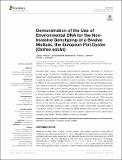Files in this item
Demonstration of the use of environmental DNA for the non-invasive genotyping of a bivalve mollusk, the European flat oyster (Ostrea edulis)
Item metadata
| dc.contributor.author | Holman, Luke | |
| dc.contributor.author | Hollenbeck, Christopher Michael | |
| dc.contributor.author | Ashton, Thomas J. | |
| dc.contributor.author | Johnston, Ian A. | |
| dc.date.accessioned | 2019-11-20T12:30:10Z | |
| dc.date.available | 2019-11-20T12:30:10Z | |
| dc.date.issued | 2019-11-19 | |
| dc.identifier.citation | Holman , L , Hollenbeck , C M , Ashton , T J & Johnston , I A 2019 , ' Demonstration of the use of environmental DNA for the non-invasive genotyping of a bivalve mollusk, the European flat oyster ( Ostrea edulis ) ' , Frontiers in Genetics , vol. 10 , 1159 . https://doi.org/10.3389/fgene.2019.01159 | en |
| dc.identifier.issn | 1664-8021 | |
| dc.identifier.other | PURE: 262530886 | |
| dc.identifier.other | PURE UUID: 7d4fc4cd-d64a-419c-8d3b-22b1b14e7d51 | |
| dc.identifier.other | ORCID: /0000-0002-7796-5754/work/65013805 | |
| dc.identifier.other | Scopus: 85077004244 | |
| dc.identifier.other | WOS: 000500991000001 | |
| dc.identifier.uri | https://hdl.handle.net/10023/18957 | |
| dc.description | Funding: European Marine Biological Research Infrastructure Cluster (EMBRIC) project funded by the European Union’s Horizon 2020 research and innovation program under grant agreement No 654008. UK Natural Environmental Research Council (grant number NE/L002531/1) (LH). | en |
| dc.description.abstract | Accurate SNP (single nucleotide polymorphism) genotype information is critical for a wide range of selective breeding applications in aquaculture, including parentage assignment, marker-assisted, and genomic selection. However, the sampling of tissue for genetic analysis can be invasive for juvenile animals or taxa where sampling tissue is difficult or may cause mortality (e.g. bivalve mollusks). Here, we demonstrate a novel, non-invasive technique for sampling DNA based on the collection of environmental DNA using European Flat Oysters (Ostrea edulis) as an example. The live animals are placed in individual containers until sufficient genetic material is released into the seawater which is then recovered by filtration. We compared the results of tissue and eDNA derived SNP genotype calls using a PCR based genotyping platform. We found that 100% accurate genotype calls from eDNA are possible, but depend on appropriate filtration and the dilution of the sample throughout the workflow. We also developed an additional low-cost DNA extraction technique which provided >99% correct SNP genotype calls in comparison to tissue. It was concluded that eDNA sampling can be used in hatchery and selective breeding programs applicable to any aquatic organism for which direct tissue sampling may result in animal welfare concerns or mortality. | |
| dc.format.extent | 7 | |
| dc.language.iso | eng | |
| dc.relation.ispartof | Frontiers in Genetics | en |
| dc.rights | Copyright © 2019 Holman, Hollenbeck, Ashton and Johnston. This is an open-access article distributed under the terms of the Creative Commons Attribution License (CC BY). The use, distribution or reproduction in other forums is permitted, provided the original author(s) and the copyright owner(s) are credited and that the original publication in this journal is cited, in accordance with accepted academic practice. No use, distribution or reproduction is permitted which does not comply with these terms. | en |
| dc.subject | Broodstock | en |
| dc.subject | Hatchery management | en |
| dc.subject | Single nucleotide polymorphism genotyping | en |
| dc.subject | Mollusk aquaculture | en |
| dc.subject | Minimally invasive sampling | en |
| dc.subject | Non-invasive genetic sampling | en |
| dc.subject | QH301 Biology | en |
| dc.subject | QH426 Genetics | en |
| dc.subject | SH Aquaculture. Fisheries. Angling | en |
| dc.subject | 3rd-DAS | en |
| dc.subject.lcc | QH301 | en |
| dc.subject.lcc | QH426 | en |
| dc.subject.lcc | SH | en |
| dc.title | Demonstration of the use of environmental DNA for the non-invasive genotyping of a bivalve mollusk, the European flat oyster (Ostrea edulis) | en |
| dc.type | Journal article | en |
| dc.contributor.sponsor | European Commission | en |
| dc.description.version | Publisher PDF | en |
| dc.contributor.institution | University of St Andrews. Marine Alliance for Science & Technology Scotland | en |
| dc.contributor.institution | University of St Andrews. Scottish Oceans Institute | en |
| dc.contributor.institution | University of St Andrews. Centre for Research into Ecological & Environmental Modelling | en |
| dc.contributor.institution | University of St Andrews. School of Biology | en |
| dc.identifier.doi | https://doi.org/10.3389/fgene.2019.01159 | |
| dc.description.status | Peer reviewed | en |
| dc.identifier.grantnumber | 654008 | en |
This item appears in the following Collection(s)
Items in the St Andrews Research Repository are protected by copyright, with all rights reserved, unless otherwise indicated.

